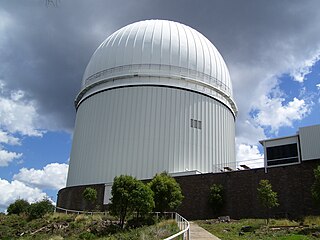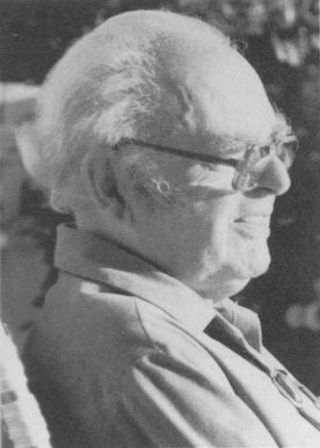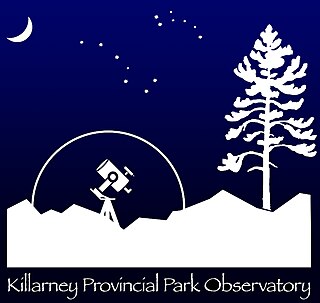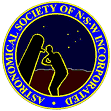
The Gemini Observatory comprises two 8.1-metre (26.6 ft) telescopes, Gemini North and Gemini South, situated in Hawaii and Chile, respectively. These twin telescopes offer extensive coverage of the northern and southern skies and rank among the most advanced optical/infrared telescopes available to astronomers. (See List of largest optical reflecting telescopes).
Boyden Observatory is an astronomical research observatory and science education centre located in Maselspoort, 20 kilometres (12 mi) north-east of the city of Bloemfontein in Free State, South Africa. The observatory is managed by the Physics Department of the University of the Free State (UFS). The Friends of Boyden assist the observatory as a public support group, organising open evenings and protecting its public interest. Boyden also makes use of members of ASSA Bloemfontein Centre, the amateur astronomy club of the city, for presenters and telescope assistants.

The Australian Astronomical Observatory (AAO), formerly the Anglo-Australian Observatory, was an optical and near-infrared astronomy observatory with its headquarters in North Ryde in suburban Sydney, Australia. Originally funded jointly by the United Kingdom and Australian governments, it was managed wholly by Australia's Department of Industry, Innovation, Science, Research and Tertiary Education. The AAO operated the 3.9-metre Anglo-Australian Telescope (AAT) and 1.2-metre UK Schmidt Telescope (UKST) at Siding Spring Observatory, located near the town of Coonabarabran, Australia.

The David Dunlap Observatory (DDO) is an astronomical observatory site in Richmond Hill, Ontario, Canada. Established in 1935, it was owned and operated by the University of Toronto until 2008. It was then acquired by the city of Richmond Hill, which provides a combination of heritage preservation, unique recreation opportunities and a celebration of the astronomical history of the site. Its primary instrument is a 74-inch (1.88 m) reflector telescope, at one time the second-largest telescope in the world, and still the largest in Canada. Several other telescopes are also located at the site, which formerly also included a small radio telescope. The scientific legacy of the David Dunlap Observatory continues in the Dunlap Institute for Astronomy & Astrophysics, a research institute at the University of Toronto established in 2008.

Bartholomeus Jan "Bart" Bok was a Dutch-American astronomer, teacher, and lecturer. He is best known for his work on the structure and evolution of the Milky Way galaxy, and for the discovery of Bok globules, which are small, densely dark clouds of interstellar gas and dust that can be seen silhouetted against brighter backgrounds. Bok suggested that these globules may be in the process of contracting, before forming into stars.

The Perth Observatory is the name of two astronomical observatories located in Western Australia (WA). In 1896, the original observatory was founded in West Perth on Mount Eliza overlooking the city of Perth. Due to the city's expansion, the observatory moved to Bickley in 1965. The new Perth Observatory is sometimes referred to as Bickley Observatory.

The University of Montevallo is a public university in Montevallo, Alabama. Founded on October 12, 1896, the university is Alabama's only public liberal arts college and a member of the Council of Public Liberal Arts Colleges. The University of Montevallo Historic District was established on campus in 1979. The school is located in a rural location in central Alabama.

The South African Astronomical Observatory (SAAO) is the national centre for optical and infrared astronomy in South Africa. It was established in 1972. The observatory is run by the National Research Foundation of South Africa. The facility's function is to conduct research in astronomy and astrophysics. The primary telescopes are located in Sutherland, which is 370 kilometres (230 mi) from Observatory, Cape Town, where the headquarters is located.

Marryatville High School (MHS) is a public state secondary school in Adelaide, South Australia. The school is situated on a large area of land in the eastern suburb of Marryatville, part of the City of Norwood Payneham and St Peters. First Creek cuts through the school grounds and large gum trees line the property. The school was founded in 1976 during the Dunstan era, from the amalgamation of the Norwood Boys' Technical High School and the Kensington & Norwood Girls' High School.

Rose Bay Secondary College (RBSC) is a government-funded co-educational dual modality partially academically selective and comprehensive secondary day school, located in Dover Heights, an eastern Sydney suburb of New South Wales, Australia. The New South Wales Department of Education established the college in 2003 as a result of the merger of Dover Heights and Vaucluse high schools.

The Sydney Observatory is a heritage-listed meteorological station, astronomical observatory, function venue, science museum, and education facility located on Observatory Hill at Upper Fort Street, in the inner city Sydney suburb of Millers Point in the City of Sydney local government area of New South Wales, Australia. It was designed by William Weaver (plans) and Alexander Dawson (supervision) and built from 1857 to 1859 by Charles Bingemann & Ebenezer Dewar. It is also known as The Sydney Observatory; Observatory; Fort Phillip; Windmill Hill; and Flagstaff Hill. It was added to the New South Wales State Heritage Register on 22 December 2000.

The University of Illinois Astronomical Observatory, located at 901 S. Mathews Avenue in Urbana, Illinois, on the campus of the University of Illinois Urbana–Champaign, was built in 1896, and was designed by Charles A. Gunn. It was listed on the National Register of Historic Places on November 6, 1986, and on December 20, 1989, was designated a National Historic Landmark.

The Detroit Observatory is located on the corner of Observatory and Ann streets in Ann Arbor, Michigan. It was built in 1854, and was the first scientific research facility at the University of Michigan and one of the oldest observatories of its type in the nation. It was designated a Michigan State Historic Site in 1958 and placed on the National Register of Historic Places in 1973.

The Heights Observatory is an Astronomical Observatory at The Heights School in Modbury Heights, Adelaide, South Australia.
Penny Diane Sackett is an American-born Australian astronomer and former director of the Research School of Astronomy and Astrophysics (RSAA) at the Australian National University (ANU). Professor Sackett was the Chief Scientist of Australia from November 2008 until March 2011.

The Killarney Provincial Park Observatory is an astronomical observatory located at the George Lake Campground of Killarney Provincial Park . The Observatory is operated by Ontario Parks and houses two observatory buildings. The original facility contains a 10" telescope with solar filter, ideal for nighttime as well as daytime viewing of the Sun. The newer facility contains a 16" fully automated telescope with a 5" refractor and is ideal for research, astrophotography and public use. The telescopes are available for Discovery programs as well as private sign-out (self-use) by interested visitors.
The Astronomical Society of South Australia (ASSA) was founded in 1892 and is the oldest society of its kind in Australia. It is the only representative body for amateur astronomy in the state of South Australia. It holds regular general monthly meetings, frequent meetings for members of specialised groups and has available two observatories, one with a 300mm telescope at The Heights School within easy reach of Adelaide and used primarily for public viewing, and a second at Stockport with 500mm and 450mm telescopes presently in service and a larger 36-inch instrument currently being considered.

The Astronomical Society of New South Wales (ASNSW) is an amateur astronomy club in the state of New South Wales, Australia, founded in 1954.

Warrick John Couch is an Australian professional astronomer. He is currently a professor at Swinburne University of Technology in Melbourne. He was previously the Director of Australia's largest optical observatory, the Australian Astronomical Observatory (AAO). He was also the president of the Australian Institute of Physics (2015–2017), and a non-executive director on the Board of the Giant Magellan Telescope Organization. He was a founding non-executive director of Astronomy Australia Limited.

Campbelltown Rotary Observatory in Campbelltown, New South Wales, Australia, was opened in 2000 and is owned by Western Sydney University. It consists of twin domes of 4.5m and 2.9m diameter. The patron of the Observatory was the late Sir Arthur C Clarke CBE. The Observatory Director (2000-2022) was the late Dr. Ragbir Bhathal. It was originally named UWS Rotary Observatory.



















